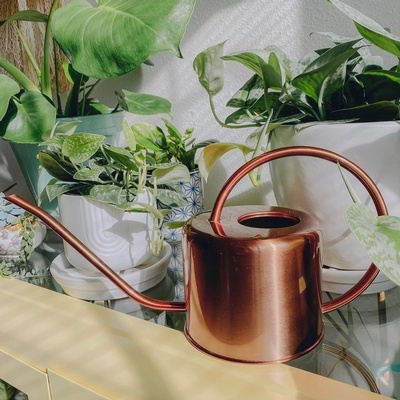A Refresher: How To Water Your Plants
 Image by @plantmedaphne
Image by @plantmedaphne
Watering our plants is an essential part of plant parenthood. But sometimes we're in over our heads on the right way to do it. When, how much, and how much is too much are the main questions we often hear.
Well, the answer is the same for all of these questions: it depends. Some plants like to have their soil evenly moist like a wrung-out sponge. Others prefer to dry out a little between waterings. And there are some plants that want water only once a month or a few times a year. We're looking at you, lithops!
It's important to know what type f watering your plant needs to live it;s best life. In our shop we indicate on your plant care card when it;s time to water your plant. We typically suggest to water based on touch rather than on a schedule. For example, if your plant care card says to water when the top inch or 2 inches of soil are dry to the touch, this means sticking your finger into the soil before watering to feel if it is dry. Using this method instead of a set schedule, you'll prevent over-watering your plant.
There are so many variables that exist and change throughout the year that will mean that your plant will need more or less frequent waterings. Some of these are:
-amount of light the plant gets
-room temperature
-heaters, air-conditioning, and nearby fans
-if your plant is in a terracotta pot or a plastic pot
If you prefer, you can use a moisture meter to see if soil is wet or dry. We always suggest keep your plant in it's plastic nursery pot Most decorative pots are designed to fit the plant and the plastic pot inside them. This will allow for necessary drainage. WHen it is time to water, be sure that you are fully saturating the soil so that the water runs out the bottom of the plastic pot. Tip out any extra water that is not soaked up in 15 minutes so your plant is not sitting in water. This will prevent root rot.
For plants potted directly into pots without drainage, it is very important to make sure you are not over-watering your plant, as there is nowhere for the excess water to go. Consider repotting your plant into a pot with drainage. Or give your plant less water, but more frequently. It is always better to err on the side of under-watering than over-watering.
For plants that want to really dry out between waterings, be aware that soil can get to a point where it is so dry or compacted that it will not readily absorb water. When this happens, the water will simply run over the edge of the soil and down to the bottom without ever being able to be used by the plant. If this happens you can use a chopstick to poke holes in the soil to loosen it. This will allow water to penetrate in. But another method is also great for plants that shouldn't get water on their leaves like African violets, begonias, and tradescantias.
Signs it is time to water:
Some plants will really let you know of when they need a beverage. Polkadot plants, fittonias, and purple waffle plants will dramatically feint like they are dead. Give them a drink and they will perk back up soon. Leafy plants will typically droop when they are thirsty. Some succulents will begin to pucker or loose their leaf stiffness when they are parched. With time you will understand what your plant is signalling to you.
Signs of over-watering:
If you notice that leaves are turning yellow, this is a tell tale sign that your plant is over-watered. Check to make sure there is not excess water sitting in the bottom of the pot. This can lead to root rot. If you have over-watered your plant, don't despair. Just remove the excess water and allow the plant to dry out. Blowing a fan over the soil surface is a great way to help the water evaporate. Or set the plant on a stack of newspapers to draw water out from the bottom of the pot.
Quality of water:
Most plants are not fussy about water quality and will be fine with tap water. However dome plants are more sensitive like calatheas, marantas, and carnivorous plants prefer distilled water or rainwater. You can purchase a large jug of distilled water from a pharmacy. And you may wish to put a bucket outside to collect rainwater. If neither of these options work for you, leave a jug of tap water out for a few days before using. This will allow some of the chemicals in tap water to evaporate off.
We're confident that you are well on your way to being plant pros! And remember, we're always here to help if you have any questions.

